
Copyright © All rights reserved.






Namibia (2012)
In June 2012 I went on my first trip to Southern Africa, to Namibia. Namibia is beautiful country, with many fascinating deserts and mountain ranges, with many different cultures and interesting people. And for me it also was the first time to be able to observe great animals like elephants, giraffes and zebras in freedom.
I spent three weeks in Namibia, touring around the country in my rental 4WD, and staying in some awesome lodges on the way. I had a wonderful time, and I am looking forward to hopefully seeing more of Southern Africa another time.
You can also find my trip report on Namibia on www.blogger.com!
Itiniary / GPS Track
Windhoek -
First impressions -
Flight was ok, quite uneventful. Even managed to sleep for most of the time. (The seat next to me was free, so this helped.) Transfer in Johannesburg was a very chaotic. Don't know why you need to go through passport control for transit; but if they them just open 3 counter, this ends up in a big chaos. Managed to still get to my connecting flight in time (and have a South African stamp in my passport as well), and two hours later I was in Windhoek.
Arrival in Windhoek was without any problem. The airport is pretty small. The next scheduled flight was 2 hours later. Had to wait a bit at passport control, then got my luggage, and headed out to get my car. An hour later, after lots of paperwork and an introduction into the car, I was on my way to the Elegant Guesthouse in Windhoek. Since most shops were supposed to be closed in the city center on Saturday afternoon, I then decided to just quickly go to a supermarket. After relaxing for a bit I then went out for dinner at the famous Joe's Beer House. There I didn't just have my first Windhoek Lager, but also my first Oryx Antelope (yummy).
GPS Track


Windhoek Airport
Kalahari Desert
After a good night's sleep, finally got on the road, towards the Kalahari Desert, leaving Windhoek on the main road to the south. Passing several mountains/hills (hard to tell as Windhoek already is on about 1600m) and rock formations. Mainly bushland, some trees. My first monkey was sitting on the side of the road. Unfortunately also my only one so far...
After about 2 hours I decided to leave the main road and take my first gravel road into the Kalahari. Very soon the first red sand dunes appeared, the road passing over one after the other. Didn't expect so many birds here in the desert, but they have built huge nests in the trees. Due to the wind I hardly felt the sun burning, but thermometer showed above 30 degree. Finally reached my destination for the night, the Kalahari Farmhouse. In the middle of the dessert a small oasis with palms, a small vineyard, pigs, cows, sheep, glasshouses to grow vegetables,... Let's see what dinner brings. And also the night (acc. to the owner it was about 0 degree here last night), but I do have heating in my little cottage.

My 4WD in the Kalahari Desert
From Desert to Desert -
One day, 350 km, half of which on gravel road, starting in the Kalahari desert, ending in the Namib dessert. And in between? I started off after a quite cold night, heading towards the coast, and quickly saw my first game, quite far from the road. Must have been some antelopes (or similar), have to check the pictures on the big screen. First stop was to see the lake with the largest dam wall in Namibia. Apparently you need a permit for almost everything, so I paid my 60 Namib Dollar.
The lake and dam wall were ok, nothing spectacular though. The lodge and restaurant were closed (apparently for renovation), and all looked a little neglected and deserted. But: the scenery around the lake was really beautiful, and I did manage to see more antelopes (much closer this time), and even a couple of zebras!
On the way further west, I first decided to fuel up my car. The indicator still showed a full tank, but I had already driven 500 km, so I didn't really trust it any more. Still not sure, why it's not showing anything, but I did get 55 liter into the tank.
Later on I also saw my first ostriches, and finally also some more monkeys. It was already starting to get late when I reached the Naukluft, behind which I would find the Namib Desert. Since I didn't go along the typical route directly from Windhoek, I had the mountains almost to myself in this great late afternoon light. Finally reached the Weltevrede Guestfarm, where I was welcome with a cold beer and dinner.

Naukluft National Park
The Lake in the Desert
Got up really early today (at five). Why? Because you're supposed to see the dunes of the Namib at sunrise. Sunrise is at about 6.30 here at the moment, but I still had to drive around 60 km to the park entrance (gravel road). So I did what I wasn't supposed to do: drive at night.
The two main reasons why you aren't supposed to drive at night in Namibia: when it's dark you don't see the dangerous parts of the street, and there are more animals around at night. Good thing was that it wasn't really dark to begin with. The moon lit up the whole area (so much for trying to get some photos of the stars at night), and twilight was starting pretty soon. As for the animals, so far it was the only time I was quite glad not to see a lot of them. Except for one Oryx Antelope, which passed the street not too far, but also not too close. But it was a really beautiful one, and I didn't know before how big they are.
I reached the park entrance shortly before sunrise, and the first time since I've been here, there was a traffic jam. It's one if the main attractions, and everybody needs to buy a permit to get in. When I finally got mine, the sun was already up, so I chose not to go to the main dunes at the end of the park right away like everybody else (another 60 km), but to stop shortly after the entrance at the first dune, to get at least some nice pics in the morning light. Then I followed to rest to the end of the normal road to the 2WD parking.
Although I do have a 4WD car, I rather took the shuttle, I didn't want to get stuck in the deep sand there (as several others did, as I saw later). I then went into the Dead Vlei, a valley in between several large dunes of red sand, in which lots of old dead tree can be found. Great place for playing around with the camera.
Hoped on the next shuttle to take me to the end, to the point where everybody rushes to in the morning, to Sossusvlei. By the time I managed to get there, most people had already climbed their dune and left again. Still trying to decide if I should try to climb one of the dunes (walking in the sand was already quite difficult), I realized that there was water in the vlei (valley). A huge lake, with lots and lots of birds (typical for water, not desert), in the middle if all the dunes in the desert. Apparently this happens about every ten years only. This year was even more special, since it wasn't the river getting more water and finally reaching the vlei, but it was only one night's rain last summer (our winter), which then came down into this vlei and created the lake. Would be interesting to see how long it will last. Therefore ended up walking around the lake instead of climbing a dune, the view of the dunes’ reflection in the water was too amazing.

Water in Sossusvlei
Special: Stuck in the Sand
I always joked about these modern cars with 4WD, these wanna-
Why am I telling this? Well, on the way to Sossusvlei, the last 5km are strictly 4WD only. Although I do have a 'real' 4WD here, due to the lack of experience in deep sand, I, as several others, decided to rather take the shuttle. On the way back to the parking, in the shuttle, we passed the following situation. A car (wanna-
The shuttle driver, knowing the conditions pretty well, offered his help, but at first there were too many people around, knowing exactly what to do. However, after all their good advice didn't help, and the car was still stuck, they started listening to our guy. The solution was: Shake it! That way some sand was put underneath the tires, and away from the middle of the car. And after less than 5 min, they managed to drive out of the sand!
The Big Vast Nothing
Started at sunrise this morning (still early for me) as I wanted to go all the way to Swakopmund today, and was told that the road there is in quite bad condition. Sunrise over the Naukluft Mountains was quite beautiful again, and I managed the first kilometers quite well. Made a short refueling break, and suddenly was in the middle of the mountains. Crossed two rivers in these mountains. Of course you have to go down all the way to the bottom and back up. Just don't ask me, why they would pave the small bit at the bottom, while leaving the steep parts as especially bumpy gravel roads.
After the mountains, on a about a third of the way, a still very bumpy road, started leading me onto a big, vast, empty nothing. Two last ostriches, and then that was it. A little lizard, and only very few bird were the only living things I saw for the next 2-
The road started to get better again, the closer I got to the coast, and to Swakopmund. Then, at the horizon, I saw something, there were the dunes again. Apparently the desert reaches right to the city (or little town, as I later found out).
As it was still early in the day, I didn't go right into town, but made a detour through another part of the Namib, called Moon Landscape and Welwitschia Plane. Still very deserted, the first bit or the drive went through a quite hilly area, apparently like on the moon. Then it went to some mountains, containing of different materials and having on top a layer from previous volcanic activities. This layer is more robust towards embodiment, leaving the mountains with a kind of black Iroquois on top. It then went down the mountains, through a (dried out river) into the Welwitschia Plane. Welwitschia is a plant growing in these extreme conditions, and scientists haven't yet found out exactly, how it can survive. But it does, and the oldest one they have found there so far, is considered to be 1500 years old.
Finally I then made it into Swakopmund, and realized, that I first need to get used back to civilization...
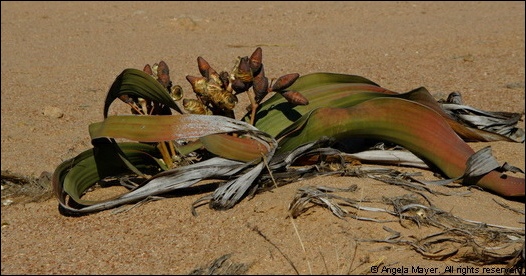
Welwitschia
Tracks in the Sand
After being in the Namib for quite a while now, I wanted to learn more about the desert, and especially who or what can actually live in these conditions. So I joined the Living Desert Adventure tour, showing us around the sand dunes just outside Swakopmund.
The guy leading the tour, Chris, had made it his task to try and save the desert. As I learned the Namib Desert is the most destroyed desert in the world. Mainly due to the extensive use of quad bikes. Due to their weight, they have crashed the top cover layer of the so-
We were to see the small five today, five small animal living on the sand dunes just outside town, which you usually would never spot. So we learned all about the good chain in the desert, where the water comes from (the typical fog in this area is the main source, and it hardly ever rains), and how to read the trails we found I'm the sand.
At first we found a chameleon, sitting in one of the bushes. Since it was still foggy, and therefore quite cold, it only moved very slow, which gave us the possibility to observe it very closely, especially also it's tongue when catching food. Then we were shown how to spot the home of the White Lady spider (a little poisonous), the desert gecko, the skunk (lizard without feet), a lizard (with feet) and the Side Winder snake (quite poisonous, but probably not deadly). Of course we (Chris) than also dug out all of the above, told us interesting/funny stories about them, and gave us the opportunity for some great photos (at least I hope they turned out great). The tour ended with a wonderful drive and view through the dunes (we learned all the different colors of the sand: in Sossusvlei they are red, here they are white, yellow, violet and black), ending with an amazing view of the dunes in front of the ocean.
And what have I learned? I learned: you're never alone in the desert.
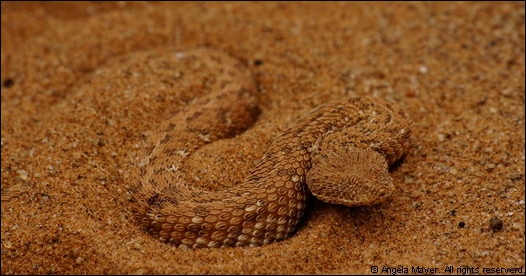
Side Winder Snake -
Back to Civilization
Having basically been almost alone in the desert since arriving in Namibia, and therefore out in the nature almost the whole time, Swakopmund came as quite a cultural shock for me.
I arrived in the late afternoon at the nice little guesthouse, owned and run by Sam, who came to Namibia from the Emmental in Switzerland, and built up his little paradise here in Swakopmund. All he needs seems to be good food, good wine, good books and his dog, Beethoven, a huge Bernersennen dog. His preference of good food and wine was quickly obvious, in the five course meal for dinner, in the breakfasts selection, in the wine tasting offered, ...
Don't get me wrong, the food in the previous places was delicious, and also really nicely presented, but the is a difference in style to getting the correct wine glasses, perfect set-
Swakopmund itself has a similar feeling of being a bit surreal to me. There are the rich white people's houses, sometimes like little villas, all shiny and new, with a big wall around them, in an unpaved, dusty street, as only the main roads are paved here. You have the pedestrian zone (the arcade), which look as artificial as Ingolstatt Village, some old big fancy buildings with German names. But at the same time, just around the corner, the simpler buildings typical for poor areas, an African street market, then again flower beds as if there wasn't desert all around. Apparently Germans really like this town because it is supposed to be so typically German. I don't really know a place in Germany that look like the 'german' part of the town. It just looks too artificial to me. Of course they are nice buildings, they just don't really fit. But all in all, it's a nice place to visit, especially subversive there is so much to do there. And it will be the last 'modern style' town for me for a while. So at the end, on my last night there, I enjoyed my crab cocktail and very delicious red wine very much.

Swakopmund
Ocean and Dunes
Already back home, I had booked this day, to enjoy the special conditions of sand dunes in the desert right next to the ocean. The plan was to go on a catamaran in the morning for the dolphin and seal cruise, then after about half the normal cruise to be dropped off on the other side if the lagoon, at Pelican Point, where I then would be picked up for a jeep tour to Sandwich Harbour, where the dunes and ocean meet. It turned out that not all would go to plan, but at the end would be a nice day after all.
It all started well, I found the right place, got on the boat, where the show started right away with a seal (which actually was a sea lion, as they are all here) hopping on board. It seemed to enjoy itself very much, of course also got a fish, which then also attracted the pelican, which came to visit us. Another bird, black, and if I understood correctly, coming from Antarctica joined us for a while. Then the next highlight, they spotted a Mola-
We came closer to Pelican Point, spotting several seal colonies on the beach, starting to look out for dolphins. We looked and looked, but only saw ocean, and from time to time a seal. We came back to Pelican Point, had a closer look at the seal colonies, and then went on to the other side if the lagoon for dolphins. Again nothing. By now the time I was told for being dropped of was already over, and we were in the wrong side of the lagoon anyway. Didn't really know what was going on. We watched two seals hunting and eating, but again no dolphins.
Then we were all called to the back of the boat for lunch. Again I was wondering what was going on, as I wasn't supposed to get food on the boat. But they had champagne, oysters from around the corner, and lots of other delicious food. As they were right in front of me, I decided to try oysters one last time (I had only tried them once, and that was very strange). They didn't only have raw oysters, but also baked ones, which were actually quite good. And even the raw ones, eaten in the Namibian style with pepper and Tabasco were quite nice, they felt more like normal mussels than what I had as oysters before. During lunch we had another seal following us for a while, and then came on board for the last 10 minutes of the cruise.
And then we were back at the jetty, without any dolphins, but also without my drop off. What had happened? They guy who came to pick me up broke down with his jeep on the way. Therefore they had to organize another car, which took a while, so they left me on the cruise till the end. We therefore started the jeep tour a bit late, which meant we had to hurry down to Sandwich Harbour before the tide would come in.
The scenery was amazing, but we had to get back before the tide as well, so we couldn't really stay very long. Then on the way back we saw them: a group of dolphins playing in the waves. We tried to follow them for a bit, but then, suddenly, flat tire. Changing a tire in the sand didn't look like much fun, but our guide, Paul, handled it white well. Meanwhile we enjoyed the time between the dunes and the ocean, and the dolphins came by again.
Then, when I already thought the tour is basically over (also because of the time), we started driving into the dunes, up and down, like on a roller-
As it was already that late, the parking was basically empty already. But the guy looking after my car (that's typical here) was still there. That's why they get paid at the end.

Sandwich Harbour
Leaving the Namib
Leaving Swakopmund this morning, I finally understood why they were always talking about the fog along the coast. It was there. Apparently I had been white lucky the days before, but now it was all foggy. Looking at the water condensed on my car, I also understood, how the plants and animals in the desert can survive.
So I left Swakopmund in the fog and headed up north. Only when I started turning east, away from the coast, after about 25 km the fog was suddenly gone. The further north I then got, the more the landscape changed. Suddenly trees started emerging, a lot of dips were on the street, which would be full of water in the raining season (but it hasn't rained here for more than a year now). Also more people lived around here, I could see huts not far from the street, or Herero women trying to sell their handcrafts along the street. So finally, it started feeling like really being in Africa. Hills emerged, stones everywhere, it looked a bit like a giant hadn't cleaned up after playing. I was finally reaching the area of Twyfelfontain (the doubtful spring) in the Damaraland.
The Area of the Doubtful Spring
I arrived in my lodge in Twyfelfontain in the early afternoon. (The name, doubtful spring, describes the spring in this area, which doesn't always give water). It was nicely situated in the typical rock formations. It's a quite big lodge (compared to what I have seen here before), and somehow I met almost everyone I came in contact with in my last accommodations. (Apparently this was the place to be.)
As it was still early I went to visit the famous rock carvings of elephants, rhinos, etc, dating from 2000-
Next morning I spent visiting the living museum of the Damara people. They are the people that originally come from this area. In the museum they show their traditional way of live to the tourists, which help them to earn some money, but also to keep their traditions alive, as there are hardly any Damaras living traditionally any more. Therefore this is also used as a school for their kids to learn about their roots. After this I made a short detour to also see the petrified forest, before I would leave the Twyfelfontain area. The petrified trees don't originate in this area, but were brought here by the river. Therefore I find it even more amazing, how big some of these trees were. Definatly worth the detour.
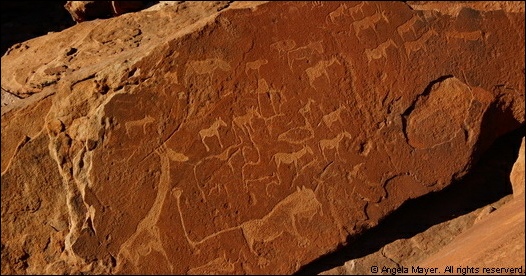
Rock Carvings
Giraffe and Elephant
Leaving Twyfelfontain towards the north, I started heading into the more remote areas of the Damaraland. For quite a while I just drove through the beautiful landscape, when I suddenly saw them. Three giraffes standing right next to the road, eating. One of them was a bit scared of my car and quickly ran to hide behind a tree (not very successful), the other two didn't really care.
When I decided I had taken enough pictures of my first giraffes, I continued hearing towards the Palmwag lodge. Shortly before the lodge, I had to pass the veterinary fence, separating the parts with and without foot-
The lodge was in the middle if nowhere, and due to missing fences, I was told not to walk around on my own after dark. Well, that was the official version I had to sign. In reality no one really cared and saw it as a risk, as long as I stayed in the lodge area.
Next morning all the smoke was gone again, and I went on my first game drives (one for sunrise, one for sunset). Sitting in an open landrover (very cold especially in the morning and with the wind), we went on some tracks through the bushland, looking for animals. And we found: lots of zebra, springbock, oryx, a few giraffe, jackal, ostrich, stenbock, one kudu, and even some eagles. Unfortunately, most of them were quite far away, but I guess that's normal for wild animals. And no elephants. The elephants here in this area are specially adopted desert elephants, but therefore also quite rare and shy, so I wasn't too surprised that we didn't find any. But one can hope...
After the second night at Palmwag I made my way to the next destination, further east, close to the western part of the Etosha National Park. On the way down the Grootberg pass (driving a pass like this and through the mountains on gravel roads is a quite interesting experience), I finally saw them (after some help from other tourists): a group of desert elephants, slowly making their way along the hill and eating. They even had two young ones with them. My first elephants! (And shortly afterwards I passed a 'cautions elephants' sign, which looked run over by an elephant.)
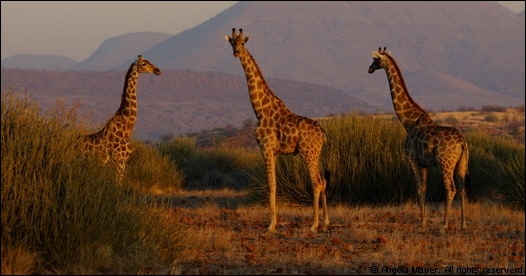
Giraffes at Sunset
The Flat Tire
Now it happened: I had a flat tire. On the way to my new lodge, the Toko Lodge, all looked still fine. At the petrol station (apart from the many people trying to sell me stuff), even offloading at the lodge it still looked normal. About half an hour later (I was just photo hunting around the lodge, a really beautiful place by the way), when one of the guys working there showed me that flat tire. It must have happened just on the way here, with the hole being small enough so the air didn't all get out immediately. But now I was so lucky, already being at the lodge, that I got help right away. Herman, their mechanic, removed the tire, found the hole, quickly repaired it (looks so simple when you know what you're doing), and put the repaired tire back on. In less than an hour it was all done. (Since I'm staying here for three nights, I still have some time to see if the repair really works, it just all looked to easy). Thank you Herman!
In the River
For today, I had booked a guided day trip through the very remote areas of the Damaraland, which would take me along the Ombonde river, on a 4x4 track, basically all the way back to Palmwag, where I've been the night before.
Jürgen, the owner of the farm I was staying at, took me on the drive. Going through the beautiful landscapes, he didn't only explain to me all there was about the trees and animals we saw, but also about live in Namibia and about him farm. I really learned a lot on this trip. We went on a quite small road towards north west, where we soon had to pass the veterinary fence again. Apparently they are expecting heaps of tourists passing through that track in the next years, as they are currently building a huge control point there (bigger than the one at Palmwag).
After the fence, then soon came to the river, in which we then went, and continued driving in the river. But river in Namibia usually means only riverbed, there is hardly ever any water in it. As was expected, this was also the case today. So we drove in the riverbed, sometimes quite sandy, sometimes quite high walls on the side, lots of big trees in and at the edge of the river. We saw lots and lots of birds, quite a few springbock and oryx. They were usually quite scared of us, and tried to leave the river as soon as possible. We came along a quite beautiful canyon, and only after almost 100 km in the riverbed, there started an area, where there actually was a little water in the river. Then we left the riverbed, but still continued following the river through the wilderness.
Finally, we reached the main road again, a little bit north of Palmwag, and started our return trip along the same route I had taken yesterday. But in areas like this, taking the same road twice doesn't get boring. We passed another desert elephant (much closer than the day before), lots of giraffes, and a few kudu, also quite close. As it was quite a long way we went today (more than 500 km), we didn't make it back to the lodge before dark, and dinner was already waiting.
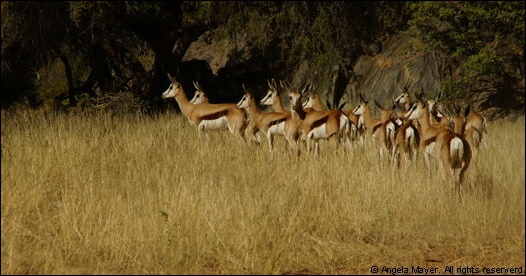
Springbocks in the Riverbed
Kaokoveld -
Another day trip with Jürgen, the owner of the Toko Lodge. This time we went up north, leaving the Damaraland, to catch a glimpse of the Kaokoveld. Only q glimpse, as most parts of the Kaokoveld are only accessible on a several-
Before visiting a Himba family up there, we first went through Opuwo for fuel and shopping. Opuwo itself is an interesting mixture of all kind of Namibian people. Due to its proximity to Kaokoveld, Damaraland, and the Ovamboland north of Etosha (more than half of all Namibians live in this small region), a wild mixture of traditions and styles can be observed in Opuwo. Starting with completely chic modern dresses, to the Victorian style dresses traditionally worn by the Herero women, to Himba men with the traditional loincloth, but also t-
The whole area up north, north of the veterinary fence, is owned by the communities, and the people are living everywhere, usually taking care of cows or goats. There are no fences, they animals are just walking around, trying to find food. But it seems to be too many animals for the available food, all grass is eaten, the cows still look very thin, and no wild animals live here anymore, as no food is left.
After stopping in Opuwo we went to visit a nearby Himba family. Jürgen has visited this family several times before, and also knows some Himba language, so he could explain and translate what they showed us. At first we offloaded the things we had brought for them: water, corn flour, bread, sugar, dog food (Jürgen has taken the brother of the dog here home with him, and now always compares how thin the dog here is). In this family, at the moment only a mother and her daughter live there with their children. And they have a lot of neighboring families in the area, who also saw us coming. The husbands only come home every few months, the rest of the time they are out with the cows, trying to find food for them.
We were invited into the main hut, which is the hut of the mother. The walls of the huts are made of wood, plastered with cow dung. The roof is made of wood, and since they have a fire inside, this wood looks and smells a bit smoky. To store valuables, there is a box with a lock; the key is worn on one if the many necklaces.
Himba women spend of lot of time to get pretty every day. I get shown how they get their skin in the typically red color (rubbing it with powder of a certain stone), what kind of perfume they use (a certain mixture of herbs, put into a fire and applied like a sauna), what is special about their hair (most of it is fake, only extensions, since true natural hair is only a few centimeters), which they then also cover with the red paste.
I saw how they make flour out if the corn they are growing (2 stones), saw a few sheep and goats running around, the cows would be gone with the husbands. I can't explain the whole Himba tradition here, I also only got a small glimpse into their real live. It really seems to be a live full of traditions (everything has a specific meaning, from the layout of the huts to the hair-
And a live, that can't really be combined with the modern live, there is no in-
On the way back then, looking out not to hit any cow (if you do, you have to pay the damage to your car, and also compensation for the cow), I saw my first rhino. We were right at the border to the western part of the Etosha National Park, and it was just walking slowly along the fence. Since the wind came from the right direction, it couldn't smell us, so we could get a bit closer for a nice photo. Full of new impressions, I arrived back at the lodge for dinner (kudu schnitzel).
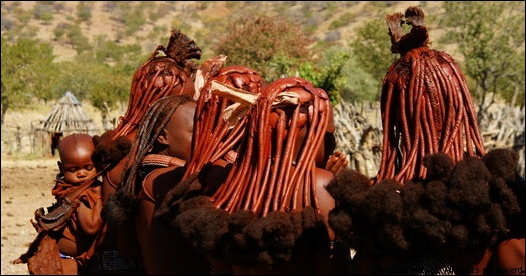
Hair Style of Himba Women
Waterholes
After a good breakfast and saying goodbye to Jürgen and his wife, I made my way further east, to the southern entrance of the Etosha National Park. I had to sign the waiver and all the park rules, the main ones being: you are only allowed in the park between sunrise and sunset, and you are never to leave your car while you are in the park. The only exceptions are when you are in one of the fenced in camps inside, where I would also stay for two nights. So I got to the camp, checked in, paid my entrance fees, and got settled in.
The park is paradise for animal viewing. Don't get me wrong, you don't necessarily see heaps of animals as soon as you enter the park, and it can also happen that you drive around and don't see any for two hours (except for the birds you see almost everywhere, and the one or the other springbok, as they also seem to be everywhere). But when you see them, you quite often see big herds. Sometimes just on or next to the street, even more close to one of the waterholes. Since it's dry season and not so much water around, they usually have to come by to drink.
My Etosha experience started at the waterhole at my camp, Okaukuejo. After getting settled, I went there just to have a quick look, and within five minutes I saw a huge herd of springbok (seemed to be never ending), a group of zebras (maybe 10-
Later I went to dinner quite early, so I could be back to our waterhole (which was lit up by night) by 7, to watch the animals coming after dark. And there they came: first two rhinos, then two more, a group of giraffes (with their young ones), three elephants, an oryx, a few jackals, and even an owl. They all were quite relaxed, enjoying the water, and didn't really care about the others. From far I could hear lions roaring and hyenas laughing, but none of them showed up while I was still there.
Next morning I tried to get up quite early, and started of for a whole day driving around in the park. Apart from what became quite standard quickly (like herds of springbok, zebras, a giraffe here and there, as well as an oryx), I saw a few more kudus (they also taste very good, as I realized again at dinner), a few really mice birds, a few really cute squirrels, a whole elephant family right next to the street, and my first three lions. At night I saw again a few rhinos, zebras, and a younger elephant. I didn't manage to stay as long this night, as it was just getting too cold.
Next day again, I made my way through the park, as my next lodge was just outside the eastern entrance. Because of their unfortunate rules that entrance fees are per 24 hours, I had to be out of the park by 2, so I couldn't have a look at every waterhole on the way. Also I couldn't see that many animals today (still a lot, just not as many as the day before). I already thought it's because they also have a day off on Sundays, but at my new lodge I was then told it's because of the wind, when they tend to hide a lot more. So I guess it wasn't so bad that I had to leave the park so early, and that way I could spend a nice and relaxing afternoon at the waterhole of the Omguma Bush Camp.

Zebras at the Waterhole
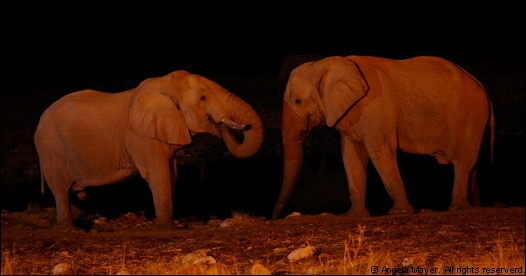
Elephants at Night
Lions, Rhinos and Elephants
I was staying two more nights just outside the Etosha National Park, at Omguma Bush Camp, which is also surrounded by a big game park. I decided to take it a bit easy and go on some guided drives instead of driving through the park again on my own (I had already done almost 500 km in the park looking for animals).
It started of with a night drive in the Omguma reserve, looking what is happening after dark. It was freezing cold in the open landrover, so I was very glad about the blanket and hot water bottle provided). As it was that cold, we mainly saw the antelopes and jackals trying to find some shelter. Also interesting that with each herd of springboks, there was one gnu for protection. We weren't very lucky with all the nocturnal animals, the only ones we saw was the spotted genet hiding up on a tree, and a rabbit. I guess most animal were trying to hide from the cold and wind. But at the end we even saw a small chameleon sleeping on a tree.
Next morning I had to get up early again, as we went on a tour through Etosha from sunrise to lunch. It still seems to be quite quiet with tourists at the moment, so I was the only guest on the tour (and two guides from the lodge). I was told that all the guides are connected with radio, so if one finds something interesting, the others would know as well. However, our car wasn't yet equipped with the radio. So he would use his mobile phone from time to time. We saw a few giraffes close to the first waterhole (with a baby of about 2 weeks), some springbok and gnu, then again nothing. Eric, the guide, called up the others, also No interesting finds yet.
We go to the next waterhole, and we see a whole lion family drinking water. Nine lions, one big male, two older female, one young male, and several cubs. They were drinking, playing, stretching, really cool. (Of course then we told some others to come to this waterhole as well). It lasted for about 15 minutes, then they all had enough and went back into the bushes to find a nice resting place for the day. As they were gone, we also left the waterhole, looking for other animals.
After a while Eric spotted a rhino quite far away. We watched it for a bit, and saw that it actually was coming towards us. This was a white rhino (before I had only seen the black ones), which us supposed to be the peaceful one, not the aggressive one. We just stood there with the car, and the rhino came closer and closer. And it didn't look too happy about us being there. So we backed away a little (even though it's the peaceful one, we don't have to start a fight), but the rhino came after us again. Just after we backed away even further, it slowly moved on, still not completely convinced that we are harmless. A bit further then we also saw a black rhino, but this one didn't really care about us.
The next waterhole then was empty (except some birds), but the one after this we got a quite amazing view again. A big family of elephants was drinking (at least 15-
After this exciting morning we went back to the camp, where I enjoyed the sun for a while. In the afternoon I went for another drive, a sundowner drive (very typical here) in the Omguma reserve. For the sundowner you drive around for 1-
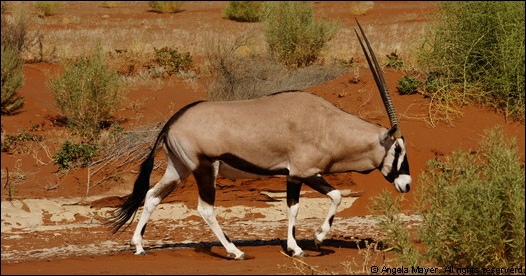
Oryx Antelope

Lion Family at the Waterhole
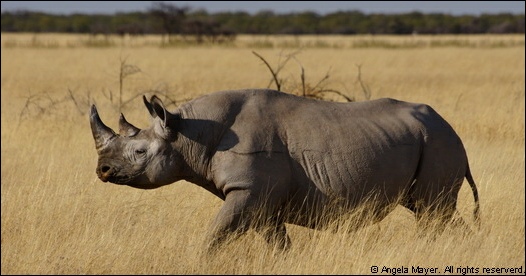
White Rhino in Etosha
Broken legs -
Leaving Omguma, I started heading south again, slowly back towards Windhoek. I decided not to take the main road to my next lodge, but a smaller road through the farmland. The problem with the main road was, that it would've been 200 km longer, therefore although it was tar instead of gravel still a bit longer. Also I was told that on the main road from here to Windhoek I would have to be a bit careful, and better not stop anywhere. So because of all this, I chose the other road.
At first I made a short stop at the meteorite, apparently one of the largest existing. Don't really know what I expected, but was actually a bit boring, just a stone. From here on the landscape had changed quite a lot, I was now in typical farmland, either corn fields or cattle farms. The only problem driving through farmland are the gates. Most farm have gate across the street. The standard rules apply: If it is open, leave it open, if it is closed, close it again after you. As I had read before that usually kids would come running to open the gates hoping for so sweets, I had brought some with me especially for this. Summary: In about 100 km there were 8 gates, all of the closed. Only once a kid came running, twice an adult opened it for me (they didn't get any sweets), and the rest of the time I had to do it myself. And what do I do with all my sweets now?
I then arrived at my new lodge and found out I would be the only guest for tonight. Feels actually a bit strange to know that all these people are now only working for you. The lodge lies in a huge property, which is nowadays only used to keep wild animals for the visitors. Since they have quite a few animals, usually at the end of the dry season, they help out with some extra food for them, as not enough is left. Also for a few years now they have a few hippos, which usually only live further north, where there is more rain. And since hippos need up to 60 kg of grass every day, they also feed the hippos. I went on a sundowner drive to the hippo lake then, and didn't just see the hippos, but also buffalos and white rhinos. Since they knew that there was food for the hippos, they also wanted some. When the hippos then came out of the water to eat, I could see that one had a broken leg and couldn't really walk anymore. Poor thing! Apparently it broke it a year ago, running and dripping into a hole in the ground. Since this hippo now really can't get any food for itself, they took more care of it, and my guide always tried to chase away the rhinos trying to steal the grass. I wouldn't have dared to get as close to the rhinos (even though it was only the white ones), but I guess the rhinos knew they wouldn't get any more food tomorrow if they hurt him. (But even I could see that they weren't really happy.
Next morning after breakfast I then got to see the feeding of the cheetahs. Cheetahs are endangered here, since the farmers don't really like them and hunt them. On this farm they usually let the cheetahs live, as they would only pass by this area. A while ago, however, they had found and injured cheetah lady, who had fallen into a canal and broken a leg, which had grown back together wrong. So also this cheetah wasn't able to catch food for herself anymore. So they took her in, gave hear a big fenced in area to live, and fed her so that she would survive. A bit later then they got a male cheetah from the Cheetah Protection Center to join her. This one apparently grew up in captivity, and then was let free. As he had never learned how to hunt for himself he almost starved, before he was found and saved. So this way I also got to see the two cheetahs up close (since I didn't manage to see one in the wild).
Finally I left the lodge again and made my way down to Windhoek, this time on the main road (there was no nice alternative), but as promised without stopping on the way.
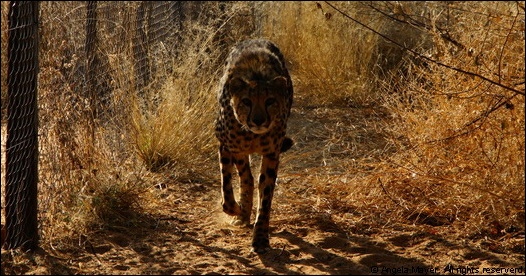
Cheetah
Windhoek
Arrived at my last lodge early in the afternoon. It's located quite close to the airport, but unfortunately still too far to watch the airplanes. The road leading to the lodge from the main road was quite interesting; I'm glad I didn't come here on my first day. When I arrived it was all very quiet, I was shown my room (this time without heating, but with warm water bottle), and found out I would be the only guest again for the first night.
As the holiday was slowly coming to an end, I decided to go on one last sundowner drive through the farm. But as it was very windy, we didn't get to see many animals (still more than we would in Germany). I then got my dinner and back to the room to get my hot water bottle ready. Just then all light went off in my room, the fuse had blown. As I didn't know where the fuse box was I tried to find someone, (I had already said good night to everyone, so I didn't know where to look). It wasn't a problem, the girl from the reception was still around on the grounds, as were two security people, who fixed my fuse right away. (Still a bit weird, to be there in the darkness, hearing the hyenas laughing in the distance…)
Next morning it was all foggy; happening about once a year in this area. (I guess since I hardly had any fog in Swakopmund, I needed some here.) But the sun slowly started breaking through after breakfasts, and I made my way into Windhoek. Even though it's the capital and biggest city in Namibia, it still feels more like a little town. Ok, I didn't go into all the suburbs, especially tried to avoid the townships (called the same, but not anywhere near as bad as in Johannesburg). I basically only went into the city center, which I could easily walk through.
Looked at some of the old, typically german buildings, like the famous Christuskirche. But a lot of them are in between newer, 80s style, not especially nice buildings. There is a weird mixture of shops, of course souvenir shops with anything you can imagine and might have to do with Africa, a crafts gallery where you can actually watch a few people create the crafts (so you know it's not just cheap China import), extremely expensive jewelry shops, especially diamonds, a street market where people from all over the country try to sell their crafts, ... Also the other shops, from the cheapest bargain shops and people trying to sell stuff on the streets, to high end cloth shops (didn't see any of the big names, but still defiantly too expensive for me). What I had already seen in Swakopmund also existed here from time to time: some shops had a closed gate, which would be opened by one of the security people (they existed in every shop anyway), so that nobody could just quickly get in or out.
After I had spent enough money I went back to my car, paid for parking and for the guy looking after my car, and returned back to the lodge. Shortly before I reached it, a tree wad blocking the street. As there was even more wind than the day before, a bug branch of a dead tree had collapsed. But as the area next to the street wasn't much different to the street, I just drove around. (Of course I told them in the lodge, so that new guests wouldn't have a problem finding the way).
3912 km
Last night in Namibia. At least I wasn't the only guest again at the lodge this time. Finished packing after breakfast, then stayed a little bit linger out in the sun, watching the birds. As I had to leave the lodge at 11, went to the airport a bit early and returned the car. Now it's been 3912 km since I got the car three weeks ago. All was fine with the car, they were happy that I didn't have to pay to get my tire fixed (as I had insurance, they would've had to pay).
Had to wait about an hour for the check-
The End
Flight to Johannesburg was quite uneventful. Passport control at transit there wasn't a problem this time, and then I was in the big shopping mall called Johannesburg airport. It sees you can buy everything that might be expensive (duty-